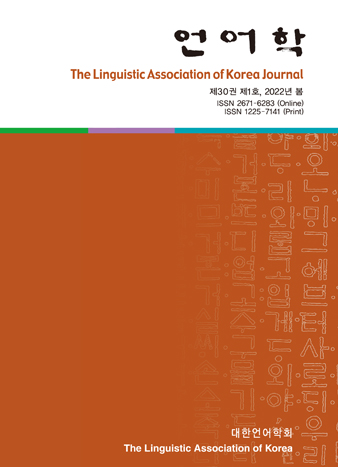대한언어학회 전자저널

30권 1호 (2022년 3월)
- 중세영어 개음절 장모음화에 대한 최적성이론 분석
-
오영일
Pages : 73-92
Abstract
Oh, Young-il. (2022). An optimality-theoretic analysis of open syllable lengthening in Middle English. The Linguistic Association of Korea Journal, 30(1), 73-92. This study provides an analysis of Open Syllable Lengthening in Middle English (ME) within the framework of Optimality Theory. Unlike previous constraint-based studies (Sohn, 2005a, 2005b, among others), this study introduces constraint reranking and shows a gradual process of Middle English Open Syllable Lengthening (MEOSL). The data dealt with are ME nāme /na:mə/, ME god /god/, ME alfe /alfə/, and ME fugeles /fugeləs/, and the constraints used are Max-Seg, FtBin, Dep-μ, and NonFin. The constraint hierarchy for pre-MEOSL is Max-Seg 》 FtBin 》 Dep-μ 》 NonFin, and the hierarchy for post-MEOSL is Max-Seg 》 FtBin 》 NonFin 》 Dep-μ. For MEOSL in progress, the unranking process occurs between Dep-μ and NonFin, and the hierarchy is Max-Seg 》 FtBin 》 Dep-μ, NonFin. With these hierarchies, this paper offers a consistent explanation for both examples of and exceptions to MEOSL and properly represents a gradual process of diachronic sound change.
Keywords
# 최적성이론(Optimality Theory) # 제약 재위계(constraint reranking) # 개음절 장모음화(Open Syllable Lengthening)
References
- 권영국, 문지순. (2014). 초기영어의 3음절 단음화 현상에 대한 소고. 언어, 39(4), 701-717.
- 이세창. (2010). 음운과정의 불투명성에 관한 연구: 보상적 장음화에 대한 포괄적 재분석을 중심으로. 언어, 35(1), 229-245.
- Bermúdez-Otero, R. (1998). Prosodic optimization: The Middle English length adjustment. English Language and Linguistics, 2, 169-197.
- Cho, Y. Y. (1998). Language change as reranking of constraints. In R. M. Hogg & L. van Bergen (Eds.), Historical linguistics 1995 (pp. 45-62). Amsterdam and Philadelphia: John Benjamins.
- Dresher, E., & Lahiri, A. (1991). The Germanic foot: Metrical coherence in Old English. Linguistic Inquiry, 22, 251-286.
- Green, A. D. (2001). The promotion of the unmarked: Representing sound change in Optimality Theory. Unpublished manuscript. University of Potsdam, Potsdam.
- Jones, C. (1989). A history of English phonology. London: Longman.
- Jordan, R. (1974). Handbook of Middle English grammar: Phonology. Translated and revised by E. J. Crook. The Hague: Mouton.
- Kim, M. (1993). On lengthening in the open syllables of Middle English. Lingua, 91, 261-277.
- Kim, S. (1997). On nonlocal compensatory lengthening. Theoretical Linguistics, 23, 1-19.
- Kim, Y. (2000). Prosody and vowel lengthening in Middle English. The History of English, 10, 29-59.
- Kim, Y. (2004). Prosodic markedness and phonological weakening process in Early English. Paper presented at 2004 International Conference English Linguistics.
- Lahiri, A., & Dresher, E. (1999). Open syllable lengthening in West Germanic. Language, 75, 678-719.
- Millward, C. M., & Hayes, M. (2012). A biography of the English language (3rd ed.). Boston: Wadsworth, Cengage learning.
- Minkova, D. (1982). The environment for open syllable lengthening in Middle English. Folia Linguistica Historica, 3, 29-58.
- Mossé, F. (1968). A handbook of Middle English. Baltimore & London: The Johns Hopkins University Press.
- Murray, R. (2000). Syllable cut prosody in Early Middle English. Language, 76, 627-654.
- Oh, Y. (2002). An optimality-theoretic account of diachronic consonant cluster simplification in English. Language Research, 38, 1217-1234.
- Oh, Y. (2011). Representation on the diachronic change of English kn-cluster in optimality theory. The Jungang Journal of English Language and Literature, 53(4), 259-275.
- Ritt, N. (1994). Quantitative adjustment: Vowel lengthening and shortening in Early Middle English. Cambridge: Cambridge University Press.
- Sohn, C. (2004). On the nature of Middle English Open Syllable Lengthening. The New Korean Journal of English Language and Literature, 46(2), 186-205.
- Sohn, C. (2005a). An optimality-theoretic account of Middle English Open Syllable Lengthening. Korean Journal of English Language and Linguistics, 5(1), 79-93.
- Sohn, C. (2005b). Unifying quantitative changes in Middle English. English Language and Linguistics, 19, 215-234.